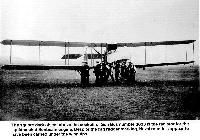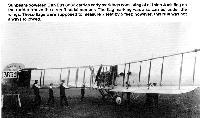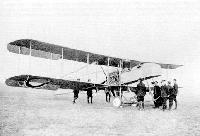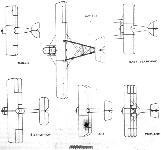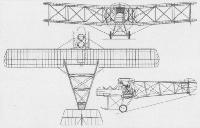H.King Sopwith Aircraft 1912-1920 (Putnam)
Pushers and Gun Buses
Just as it has been thought fit to accord a single chapter to the Bat Boats, their notable variations notwithstanding (for in truth they represented a species rather than a type) so, now, we consider those wholly individual Sopwith products genetically called 'Gun Bus' though including also the 'Greek Seaplane' and the Pusher Seaplane Gun-carrier No. 127'. (Though the Bat Boats were themselves of pusher form they had, as we have seen, a very strong marine individuality of their own).
The true chronology and lineage of the family of floatplanes and landplanes now to be studied is indeterminate and unimportant; but they were all of 1913/14 vintage - even though production of the last Robey-built landplanes was still in hand late in 1915.
<...>
No less comprehensible, in the early months of war, would be conversions of seaplanes to landplanes, and vice versa though equally so the description Gun Bus (with initial capitals) could be strictly applicable only to RNAS landplanes of the general type now to be considered. (This having been said, it must still be emphasised that the term 'gun ‘bus’- being a generic and colloquial one - had been used in print, as already exemplified, as early as 1913 to describe a Sopwith aeroplane).
Now to extricate the Gun Bus (with initial capitals to connote its RNAS landplane status) from its near-relations. This aeroplane was a four-bay biplane with a four-wheel landing gear, the wheels being in two close-set pairs mounted one on each side of a cable-braced skid, which was itself attached to the outer ends of the lower centre section, and thus reminiscent of the original 'hybrid' tractor. Another 'family' resemblance was the forward raking of the struts between the four converging booms, on which the monoplane elevator/tailplane assembly was fixed. The single, comma-shaped rudder had a horn-balance portion wholly above this assembly, and the engine was a Gnome. Nacelle-shape, nevertheless, may well have varied; but a splendid photograph survives (and is now reproduced) showing not only the general shape with a 'cuniform' nose but also the installation of a Lewis gun. The gun is seen to be of land-service pattern (with the characteristically massive cooling jacket, or, more strictly, radiator by reason of its internal finning) and is secured to a cranked-pillar mounting. Covering the ejector slot of the gun is a deflector/collector assembly to restrain and contain the spent cartridge cases; and this component may well have been made up at Hendon, where this particular early Gun Bus was stationed. Certainly it is of unfamiliar pattern - and equally certainly it would be unsafe to regard the Gun Bus shown as representing 'standard' practice, for the times demanded what the Navy traditionally knew as ‘make and mend'. That the Gnome Monosoupape engine of 100 hp was generally fitted seems probable; and this was one important respect in which the early RNAS Sopwith Gun Bus differed from a developed, or 'intermediate', model. Sopwith-built 'intermediate' Gun Bus aircraft were officially styled Admiralty Type 806, though the actual Service numbers of the aircraft concerned were 801-806. The designation Gun Bus No.2 may well have applied in this instance but though convenient and explicit would not strictly conform with the Navy's system of numbering (say) lieutenants ('Number One' or 'Jimmy the One' being the classic instance).
In the Admiralty Type 806, with the design of which Herbert Smith and R. J. Ashfield were closely concerned, the engine was a water-cooled 150 hp Sunbeam (retrospective class-name Nubian) installed at the rear of a wholly new nacelle, which was slightly raised above the lower centre section instead of being directly attached as formerly; the elevators were stronger; the lower centre section was reduced in chord; and the wing trailing edges were given little cut-outs to afford easier acceptance of the tail booms, which were subject to distortion in the air.
A word about the engine seems in order, for the 150 hp Sunbeam was a fairly obscure powerplant, and one with particular RNAS associations. Like the Rolls-Royce Hawk, it seemingly achieved its greatest distinction in airships.
Perhaps the most noticeable feature of the Admiralty Type 806 was its new two-wheel cross-axle landing gear, with revised attachments and bracing. Though the track of this new gear - the wheels whereof were rubber-bound to skids as formerly - was relatively narrow, this was greatly accentuated by the 50 ft (15.2 m) wing span.
What may be considered as the definitive version of the Gun Bus (for, as noted at the outset, production was still in hand late in 1915) was built not by Sopwith themselves, but by Robey & Co Ltd. of Lincoln; and that the order called for only thirty machines, and had been placed (in May 1915) with an engineering company that dated far back into Victorian times may at first seem strange. It could, however, be regarded otherwise. In the first place, the order might be compared with at least two other obscure contracts for pushers-specifically the D.H.1As from Savages Ltd. of Kings Lynn, Norfolk, and the Vickers F.B.9s from Wells Aviation Co Ltd. of Chelsea, London (the latter, for some mysterious reason, having different ‘RAFwire' lengths from F.B.9s built by Vickers themselves). A second point is that the Robey-built Sopwith Gun Buses had tangible Sopwith associations: Harry Hawker himself tested the first machine of the batch - No.3833 (the total order was 3833-3862, from 3850 onwards being delivered as spares); the first two examples at least were sent to Brooklands; and the drawings used by Robey were the responsibility of Sopwith's 'super draughtsman' R. J. Ashlield. One test pilot, additional to Harry Hawker, was the man who in later life became Col The Master of Sempill, Baron Sempill - a very eminent figure in British aviation and who will later be named again in connection with the Sopwith Cuckoo.
Whatever name or designation they may have gone by, it seems tolerably certain that the Robey-built Gun Buses were constructed with bombing in mind: for not only was the pilot moved to the front cockpit in the lengthened nacelle, but there were underwing carriers (set close inboard) for four - and latterly, with reduced petrol capacity, six - 65 lb bombs.
Hardly surprisingly, some of these pushers did service as trainers - at Hendon and at Eastchurch (from which latter base Tom Sopwith had set out in the old Howard Wright pusher back in 1910 to win ?4,000).
Gun Bus (as built by Robey) (150 hp Sunbeam)
Span 50 ft (15.2 m); length 32 ft 6 in (9.9 m); wing area 474 sq ft (44 sq m). Maximum speed 80 mph (128 km/h).
Показать полностью
M.Goodall, A.Tagg British Aircraft before the Great War (Schiffer)
Deleted by request of (c)Schiffer Publishing
SOPWITH school sea or land pusher biplane Type SPAz & SPGn
Admiral Kerr, who had been seconded to the Greek Navy, ordered three dual controlled seaplanes for training purposes by letter dated 13 October 1913, on behalf of the Greek government, and these were immediately put into work. The total price was .6,205 less one per cent for the fund for widows, with delivery to be made by sea in April, May and July 1914.
The British Admiralty followed with an order for two similar machines Nos.123-124 on Contract CP54578/13X15783, instructions for which were issued to the works on 25 October 1913, with delivery to the Isle of Grain finally made in March 1914 at a total cost of .2,605 as eventually negotiated.
These aircraft were assembled at Hamble and Woolston and test flown by Howard Pixton, with official acceptance, including that for the Greek machines, at Calshot. A further batch of six aircraft was ordered by the Greek government and instructions for these were issued to the works on 18 February 1914. Five were completed as pushers but one was built as a tractor seaplane similar to the 'Circuit of Britain' seaplane Type D.3 (q. v.). At the outbreak of war these aircraft known as Type SPGn were commandeered by the British Admiralty, and were delivered between July and October 1914 as serial Nos.897-901. They differed from the first batch in being fitted with Gnome Monosoupape engines and there was a requirement for the dual controls to be made removable, to enable a Lewis gun to be fitted for an offensive role. Cover was on Contract CP50330/14X13443 for a total of .18,356.
The design was of a typical pusher biplane of the period, with three bay wings and smaller center section bays. The tail booms were attached at the intersection of the outer center section struts, with the wing spars. The tail booms tapered in plan to the rudder post and the upright struts were staggered, and divided the booms into four bays. The crew were housed in tandem cockpits in the nacelle forward of the wings. The machine was mounted on two main floats on inverted vee struts, below the outer center section struts; the floats were also stabilized by struts to the lower longerons and by cables, and were sprung by leaf springs at the four main attachments. A small cylindrical tail float was fitted. The RNAS operated some machines as landplanes with four wheel, twin skid undercarriages.
The control surfaces consisted of ailerons on top and bottom wings, a semicircular tailplane, which was soon enlarged to a rectangular shape to improve stability, and a shield shaped rudder with a small balance area; the rudder was mounted between the booms and was also subject to enlargement after early tests. The engine stalling gear was also subject to breakage on the early machines.
Power:
100hp Anzani ten-cylinder air-cooled two-row radial driving a 8ft 6in diameter propeller fitted to the first three Greek and two British machines Nos.123-124.
100hp Gnome Monosoupape nine-cylinder air-cooled rotary fitted to 5 Greek machines commandeered by British Admiralty as Nos.897-901.
Data Seaplane. Landplane.
Sopwith drg.no. 119 199
Span 50ft 50ft
Chord 5ft 1 1/2in 5ft 1 1/2in
Gap 5ft.4 3/16in 5ft4 3/16in
Area 480 sq. ft 480 sq. ft
Length 30ft 2 3/4in 30ft 3/8in
Height 12ft 10ft 9in
Weight 1,485 1b. 1,185 1b.
Weight allup 2,200lb. 1,900lb.
Tail float 4ft 4in long x 1ft dia. -
Main floats 14ft long 2ft 5in
beam 1ft 11in deep
Tailplane span 11ft 11ft
Tailplane area 35 sq. ft 35 sq. ft
increased to 55 sq. ft
Elevators span 12ft 3in 12ft 3in
Elevators area 22 sq. ft 22 sq. ft
Rudder area 9 sq. ft 9 sq. ft
increased to 12 sq. Ft
SOPWITH land scouting pusher biplane. Admiralty Type 806 'Gunbus'
A batch of six pusher biplanes, similar to those built for the Greek government but with land chassis, was ordered by the Admiralty on 14 August 1914 on Contract CP02133/14X13857 with Serial Nos.801-806 allocated.
Two types of Sunbeam engine were to be supplied free issue; 110hp. engines were fitted initially to 801-802 and 805, but were soon replaced with the 150hp type, which were fitted to all six aircraft. The redundant engines were returned to the airship shed at Farnborough for disposal. The total cost for six aircraft, including engine changes was ?7,893. The first machine flew at Brooklands in early October 1914 and two were delivered to Hendon during that month, the last aircraft did not leave the works until March 1915.
The machines were supplied with a 'telescopic' gun mounting for use by a gunner in the rear cockpit, although later changes to the design of the nacelle were made, in which the positions of the crew were reversed.
The water-cooled engine required a large radiator, which was mounted on the nacelle just behind the rear cockpit. The two wheeled land undercarriage incorporated twin skids and was mounted by vee struts to points on the lower longerons at the main center section spars, with a further strut from the skids to the lower longerons. A rectangular fin was fitted within the booms.
The type was mainly used for training purposes and, although the operational life of the first batch was over by the end of 1915, a further batch of thirty aircraft serial Nos.3833-3862 was ordered in June of that year, from Robey & Co. of Lincoln, of which the last thirteen were not assembled and flown. The service life of the Type 806 was over by the end of 1916.
This was the first order for Sopwith aircraft to be placed with another contractor.
Power:
110hp Sunbeam eight-cylinder water-cooled vee in Nos.801-802 and 805 initially
150hp Sunbeam Crusader eight-cylinder water-cooled vee driving a 9ft 10in diameter Lang propeller fitted to Nos.801-806 later
150hp Sunbeam Nubian eight-cylinder water-cooled vee in Nos.3833-3862
Data Dimensions as for Type SPAz except as follows:
Length 32ft 6in
Height 11ft 4in
Area 474 sq. ft Quoted in Robey publication.
Area tailplane 28 sq. ft *
Area elevators 28 sq. ft *
Area rudder 13 sq. ft *
Area fin 8 3/4 sq. ft *
*From Sopwith drawing (WO 977) dated 4 May 1915 drawn by R.J. Ashfield passed by H. Smith
Показать полностью
P.Lewis British Aircraft 1809-1914 (Putnam)
Sopwith Gunbus
The Gunbus was a landplane adaptation of the Greek Seaplane, six of which were due for delivery to the Greek Naval Air Service when the 1914-18 War commenced, but which were commandeered by the War Office. The original 100 h.p. Anzani engine was discarded, and its place was taken by the 100 h.p. Monosoupape Gnome, the Gunbus thereafter being employed for training at Hendon. A further production batch was put in hand, several modifications being made at the same time to the original design.
Instead of being connected direct to the nacelle's sides, the lower wings were made in one piece and passed below the nacelle, which itself was improved and strengthened. The power available was increased by the installation of the 150 h.p. Sunbeam engine. The tail unit was revised also, the earlier typical Sopwith curved type of tailplane giving way to one of rectangular shape, while the rudder was balanced and increased in area. A two-wheel undercarriage was fitted, with two skids and with rubber-cord shock-absorbers for the axles. Armament consisted of one Lewis gun mounted in the nose of the nacelle.
The operational use made of the Gunbus is obscure, but the type is believed to have flown at Dunkirk with Commander C. R. Samson's R.N.A.S. Squadron.
SPECIFICATION
Description: Two-seat pusher biplane gun-carrier. Wooden structure, fabric covered.
Manufacturers: Sopwith Aviation Co. Ltd., Kingston-on-Thames, Surrey.
Power Plant: 100 h.p. Monosoupape Gnome, 150 h.p. Sunbeam.
Dimensions: Span, 50 ft. Length, 32 ft. 6 ins. Wing area, 474 sq. ft.
Performance: Maximum speed, 80 m.p.h.
Показать полностью
J.Bruce British Aeroplanes 1914-1918 (Putnam)
Sopwith Greek Seaplane and Gun Buses
<...>
In March, 1914, the Greek Government ordered six more Sopwith pushers of similar type, but required them to be armed with a machine-gun mounted on the nose of the nacelle; there was to be no dual control. Construction of these machines was under way when war broke out.
The Greek gun-carriers were at once commandeered by the Admiralty, and the mere fact that they were capable of carrying a machine-gun was an instant commendation. The machines appeared with wheel undercarriages: at first a simple skid structure was fitted directly under the first pair of interplane struts on either side and carried a pair of wheels on a short axle. The first Sopwith Gun Buses, as they were called, had the 100 h.p. Gnome Monosoupape engine, and the nose of the nacelle was modified in shape to improve the gunner’s field of fire forwards and downwards.
A more powerful version of the design appeared later, and differed in appearance from the Gnome-powered Gun Buses. The use of the 150 h.p. Sunbeam engine dictated the provision of a stronger nacelle and undercarriage. The nacelle was larger than that of the Gnome-powered version, and had deep coamings about the cockpits; it was raised slightly above the lower wing. A larger, balanced rudder and a new tailplane and elevators were fitted. The undercarriage was attached to the nacelle and lower centre-section; it had only two wheels, connected by a transverse axle which was bound to the long horizontal skids by rubber cord.
Whether any of the Gun Buses flew operationally is uncertain, but Commander C. R. Samson reported to the Admiralty on February 6th, 1915, that the equipment of his squadron, then based at Dunkerque, included “One Sopwith Gun aeroplane, [which] requires a lot of work on it to make it safe to fly.”
SPECIFICATION
Manufacturers: The Sopwith Aviation Co., Ltd., Canbury Park Road, Kingston-on-Thames.
Other Contractors: Robey & Co., Ltd., Lincoln.
Power: Gun Bus: 100 h.p. Gnome Monosoupape; 150 h.p. Sunbeam.
Dimensions (with Sunbeam engine): Span: 50 ft. Length: 32 ft 6 in. Chord: 5 ft 1 1/2 in. Gap: 5 ft 6 in. Stagger: 1 ft. Dihedral: 3 30'. Incidence: 4.
Areas: Wings: upper 246 sq ft, lower 228 sq ft, total 474 sq ft. Ailerons: each 15 sq ft, total 60 sq ft. Tailplane: 28 sq ft. Elevators: 28 sq ft. Fin: 8-75 sq ft. Rudder: 13 sq ft.
Performance: Maximum speed: 80 m.p.h. with Sunbeam engine.
Armament: One Lewis machine-gun on movable mounting on nose of nacelle.
Service Use: Probably used by Commander Samson’s squadron of the R.N.A.S. stationed at Dunkerque. Training: flown at Hendon.
Serial Numbers: 801-806: built by Sopwith. 3833-3862: built by Robey & Co.; only seventeen were delivered complete, the remainder being delivered as spares.
Показать полностью
P.Lewis The British Fighter since 1912 (Putnam)
Although the single-seat tractor scout was gradually beginning to come into its own at the time of the commencement of the War, the pusher layout - with its undoubted facilities for the installation and use of machine-guns - was being strongly pursued in the two-seat form.
In August, 1914, the Sopwith company were busy completing for the Greek Naval Air Service six landplane versions of their 1913 Greek Seaplane. The additional order had been placed in March, 1914, following the Greek Government’s approval of the first example on floats. The new machines were to be armed with a single Lewis machine-gun in the front of the nacelle and the revised type became known as the Gunbus. The Greeks never received their expected Gunbuses as the six aircraft found themselves taken over by the Admiralty. The original Greek Seaplane had used a 100 h.p. Anzani engine but this was supplanted in the production batch of Gunbuses by the 100 h.p. Monosoupape Gnome and, in order to bestow as good a field of fire as possible, the nacelle’s fore part was revised in shape.
After the batch of six were delivered, the Gunbus was revised again and received increased power by the installation of the 150 h.p. Sunbeam. The nacelle and undercarriage had to be strengthened to absorb the extra power and improved protection for the crew resulted from increasing the depth of the decking of the nacelle. In the original Gnome-powered design, the lower wings were mounted direct onto the sides of the nacelle but in the Sunbeam version they passed below it, to be attached by short struts. At the same time, a new horn-balanced rudder of increased area made its appearance and straight-edged horizontal tail surfaces were incorporated. Besides being built by Sopwith, the Gunbus was sub-contracted by Robey and Co. at Lincoln but, even though such a useful gun-carrier was available when the emergency arose, the production run of twenty-three complete machines was very small and no particularly noteworthy successes attended whatever operational use was made of the machines. The Gunbus, with its span of 50 ft., was of fair size and managed to reach 80 m.p.h. with the Sunbeam as power. Its severely restricted employment as an operational type was offset by the R.N.A.S. putting it to good use as a trainer at Hendon.
Показать полностью
F.Mason The British Fighter since 1912 (Putnam)
Sopwith Gun Bus
While it is well known that the Tabloid was the first scout to be produced by the Sopwith Aviation Company, and was later to be followed by a series of such aircraft for which the name Sopwith became synonymous, it should be said that the company had produced a wide range of other types of aircraft. One of these was a fairly large single-engine twin-float pusher seaplane powered by a 100hp Anzani radial engine for the Greek Naval Air Service in 1913.
This aeroplane proved satisfactory to the extent that a follow-up order was placed in March 1914 by that Service for six further examples to be built as landplanes, and to be armed with a single Lewis gun on the nose. These aircraft became known as the Sopwith Gun Buses, but were not ready for delivery to Greece when war broke out with Germany, and all were taken on charge by the British Admiralty. Apart from the wheel-and-skid undercarriage, the original four-bay Gun Bus biplanes also differed from the earlier Greek Seaplane in being powered by a 100hp Gnome monosoupape and the contours of the nacelle’s nose were altered to provide a reasonable field of fire for the gunner. A four-wheel undercarriage was fitted.
Later thirty further Sopwith Gun Buses were ordered by the Admiralty under sub-contract with Robey & Co Ltd of Lincoln, but of these only seventeen were delivered fully assembled, the others being supplied for spares. These aircraft were powered by 150hp Sunbeam engines whose size and weight required an enlarged nacelle and stronger undercarriage, and the lower wing, instead of being attached directly to the bottom of the nacelle, was now a continuous structure which passed below the nacelle and was secured by struts attached to the wingspars; the number of landing wheels was reduced to two, and the aircraft was fitted with an enlarged, balanced rudder.
It is believed that only one Sopwith Gun Bus joined an operational unit, the Squadron commanded by Cdr Charles Rumney Samson rn (later Air Cdre, cmg, dso, AFC, RAF) at Dunkerque early in 1915. Others were used by the RNAS for training at Hendon.
Type: Single pusher engine, two-seat four-bay biplane gun-carrier.
Manufacturers: The Sopwith Aviation Co Ltd, Kingston-upon-Thames, Surrey; Robey & Co Ltd, Lincoln.
Powerplant: One 100hp Gnome monosoupape engine driving pusher propeller (first six aircraft); one 150hp Sunbeam engine (remaining seventeen aircraft).
Structure: All-wood construction with ply and fabric covering; two-spar four-bay wings.
Dimensions (Sunbeam aircraft): Span: 50ft; length, 32ft 6in; wing area, 474 sq ft.
Performance: Max speed, 80 mph at sea level.
Production: 23 aircraft, Nos 801-806 (Gnome engines); Nos 3833-3862 (Sunbeam engines, of which only 3833-3849 were delivered assembled; remainder delivered for spares).
Summary of Service: One aircraft believed to have served with RNAS Squadron at Dunkerque; also used for training at Hendon.
Показать полностью
W.Green, G.Swanborough The Complete Book of Fighters
SOPWITH GUN BUS UK
The Gun Bus was essentially a landplane derivative of the S.P.Gn (Sopwith Pusher, gun), a gun-carrying two-seat pusher biplane with twin floats. Six of these floatplanes were ordered from the recently-founded Sopwith Aviation Company by the Greek government in March 1914, but immediately commandeered by the Admiralty when war was declared in August that year, subsequently serving with the RNAS. The Gun Bus, intended for the fighting role, carried a 0.303-in (7,7-mm) machine gun on a flexible mount in the forward cockpit and was powered by a 100 hp Gnome Monosoupape rotary engine. A more powerful version, with a 150 hp Sunbeam eight-cylinder water-cooled engine, was developed specifically for the RNAS, this having a redesigned nacelle and a revised undercarriage. Six of the Sunbeam-powered Gun Buses were built for the RNAS by Sopwith, a further 30 being ordered for the service from Robey & Company, these last being intended for bombing (and possibly anti-submarine) duties as distinct from fighting. The pilot was moved forward to the front cockpit, a bombing panel being let into the floor and four bomb carriers being fitted beneath the lower wing. The following data relate to the Sunbeam-powered two-seat fighter Gun Bus.
Max speed, 80 mph (129 km/h).
Span, 50 ft 0 in (15,24 m).
Length, 32 ft 6 in (9,90 m).
Height, 11 ft 4 in (3,45 m).
Wing area, 474 sqft (44,03 m2).
Показать полностью
H.King Armament of British Aircraft (Putnam)
Gun Bus. A photograph overleaf shows the installation of a Lewis gun on one of three pusher landplanes, of a type first constructed in 1913, in RNAS service. It will be seen that the nose of the nacelle is of such a form as to allow the gunner a certain angle of downward fire. The gun, of land-service pattern, is secured to a cranked pillar by a V-shaped attachment on the cooling jacket, and a collector box is tilted to catch the spent cartridge cases. With narrow-track two-wheel undercarriage, machines of this same type were fitted to carry four bombs under the lower wings, two on each side just outboard of the second pair of interplane struts.
Показать полностью
O.Thetford British Naval Aircraft since 1912 (Putnam)
SOPWITH GUN BUS
This two-seat pusher biplane first appeared in 1913 as a seaplane trainer for the Greek Naval Air Service. Six further Gun Buses ordered by Greece were taken over by the Admiralty in 1914 and fitted with landplane undercarriages. Serial numbers allotted were No.801 to 806. These aircraft carried a machine-gun in the front cockpit and were fitted with a 100 hp Gnome Monosoupape engine. They were used mainly for training at Hendon. Later examples were also built, as illustrated, with a 150 hp Sunbeam engine and a modified nacelle. Maximum speed, 80 mph. Span, 50 ft. Length, 32 ft 6 in.
Показать полностью
Журнал Flight
Flight, February 6, 1919.
"MILESTONES"
THE SOPWITH MACHINES
The Gun 'Bus. (1914)
As a result of their experience with Sopwith school pushers, the Sopwith firm were given an order by the Greek Government for a number of somewhat similar machines, carrying a pilot and gunner, but not fitted with dual controls. A gun was mounted in the nose of the nacelle. This order was nearing completion when War broke out, and the machines were commandeered by the Admiralty. From August, 1914, they were immediately put into service, being among the first aeroplanes to be armed, and were equipped with land undercarriages instead of the original float chassis. The earlier batches were equipped with 100 h.p. Gnomes, but later water-cooled Sunbeams were fitted. Our scale drawings and photograph show one of these machine fitted with a 150 h.p. Sunbeam. A similar machine was a very familiar sight at Hendon in the earlier days of the War, and will be remembered by many visitors to that aerodrome.
Показать полностью





